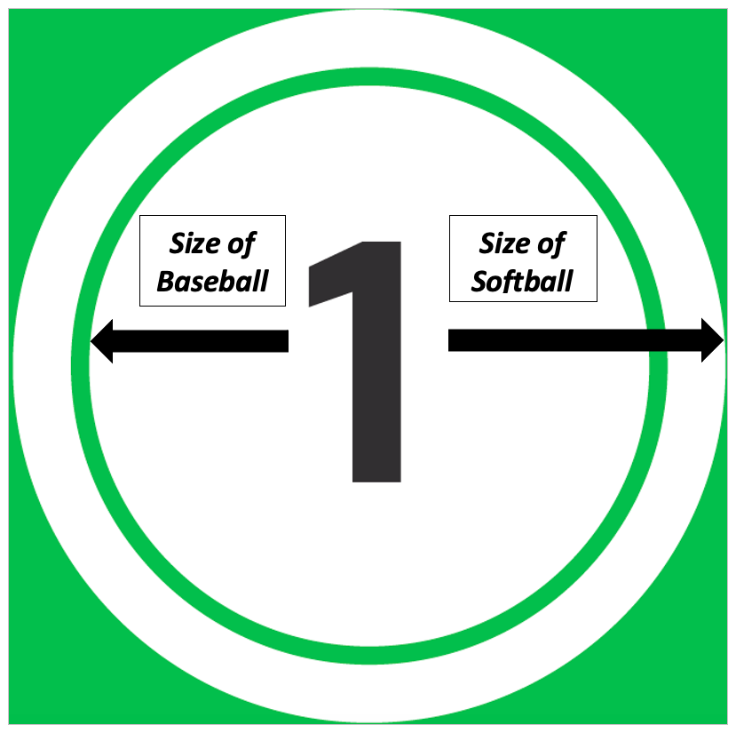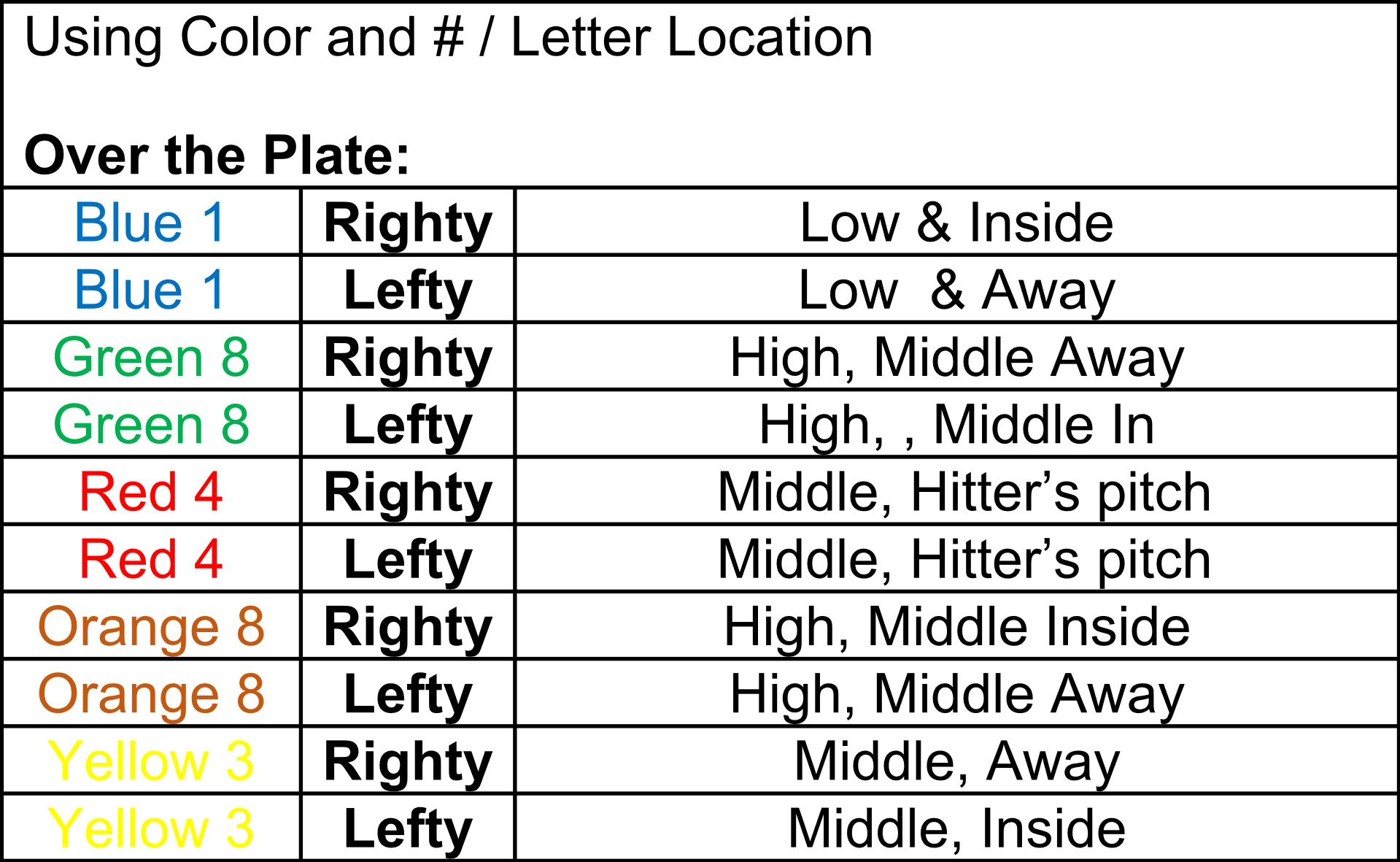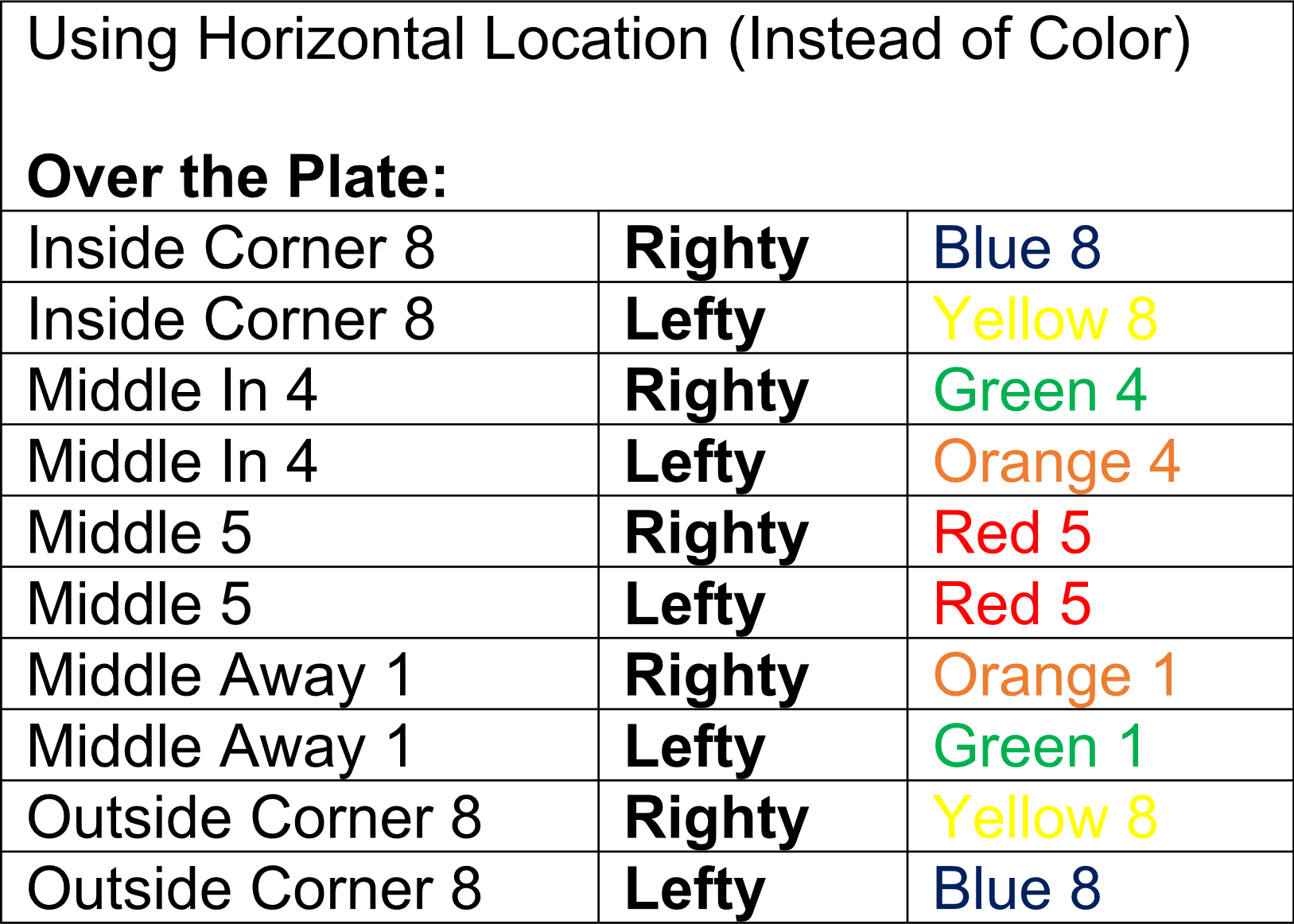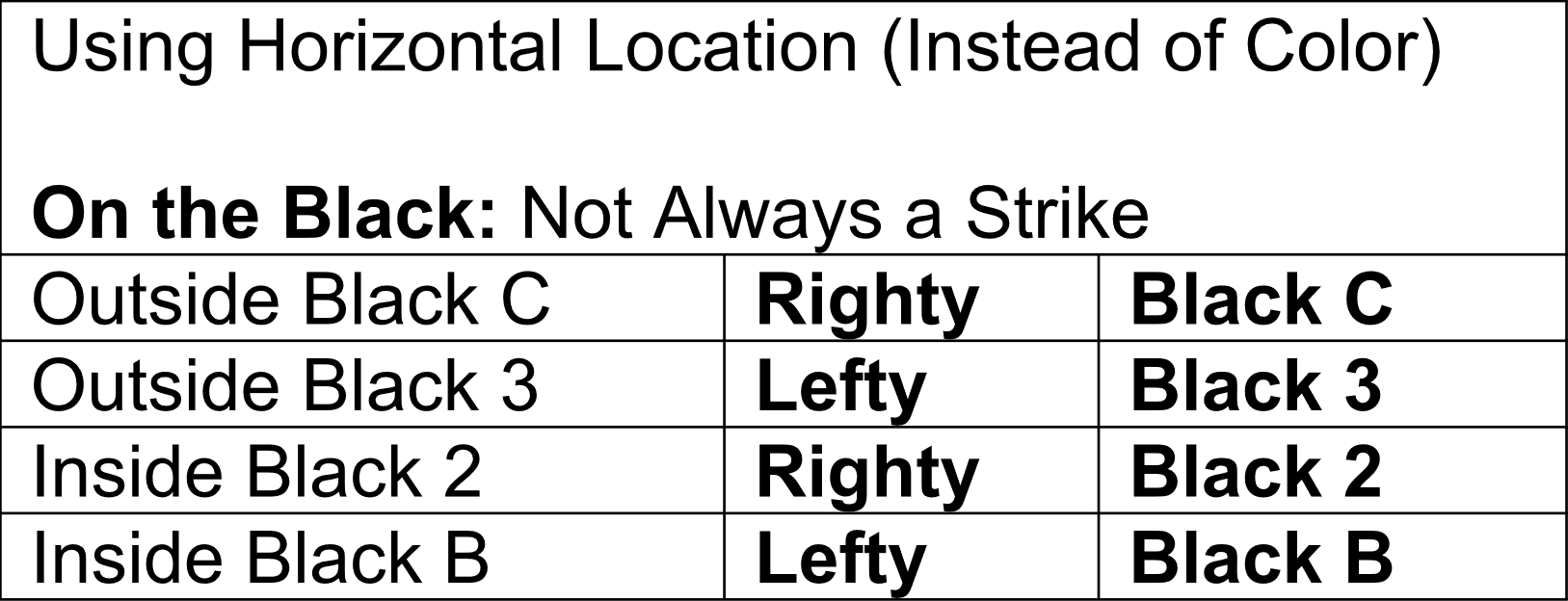Visual Aid Hitting Tool replicating the Strike Zone For Baseball and Softball Players
"It is a time efficient tool without the need for a ball or a batting tee."
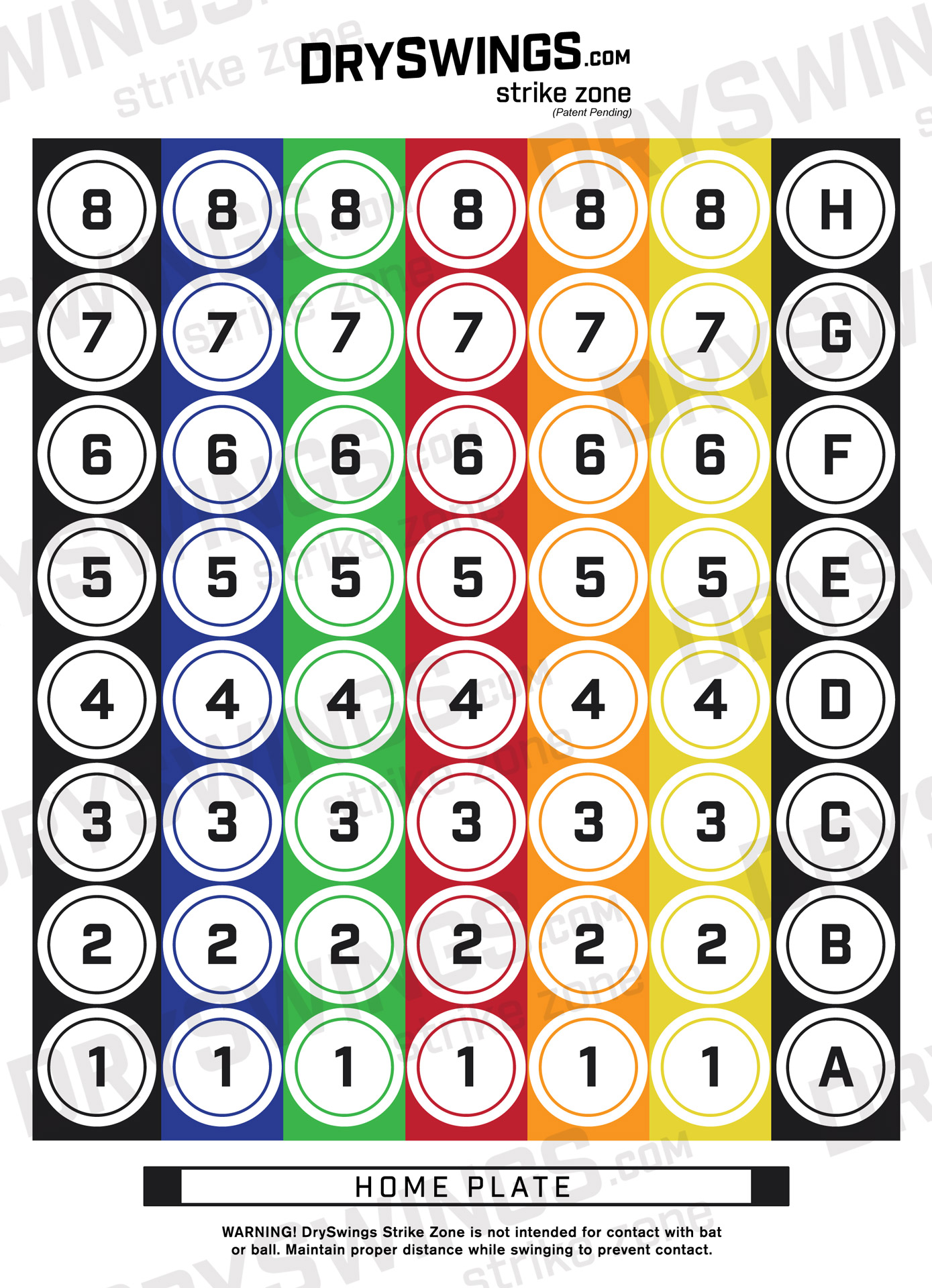
Using the DrySwings Strike Zone Visual Aid, with hard work and attention to detail, can enhance Your swing approach, improve performance and help hit any pitch in the strike zone with Authority.
What is a dry swing? You probably already know. You do it all the time. Coaches often refer to these as "practice swings" and are considered any practice swing with no contact.
The Image
The DrySwings Strike Zone Visual Aid was crafted to fit both baseball and softball players.
With the inner circle the size of a baseball, and the outer circle the size of a softball.
It is a replica of the Strike Zone, from: Knees to Letters, all 17 inches of the plate, and the inch of black on each side.
Think: Inside Black, Inside Corner, Middle in, Middle, Middle Away, Outside Corner, Black Away
Where To Use
1. Hitting Station during Batting Practice
2. On Deck Prep / In The Hole Prep (mounted on fence/wall of dugout)
3. Discussing Scouting Reports (pitcher tendencies) with hitters
4. Pitchers/Catchers discussing opposing hitters strengths/weaknesses
5. Mirror Work (home, gym, weight room)
How To Use
Instructions
*Never make swinging contact or ball contact with Visual Aid or surface it is mounted on*
1st - Find a Location to Mount
Find a location to execute swings that has a surface (net, chain link fence, mirror, wall, etc.) to attach the DrySwings Strike Zone.
2nd - Adequate Space for Swings
Recommended 4-5 feet of clearance from chosen surface. Longer swings may require more space.
Use the home plate image (bottom of the visual aid) to line up with a home plate on the ground.
This allows the hitter to set up the batter's box correctly, in order to execute full swings.
3rd - Recommended Height to Mount
Height at which the unit will be mounted is dependent on each hitter, based on:
- height of the hitter
- batting stance (to fit their strike zone)
Set up "#1's/A" even with the bottom of the hitter's knee while in batting stance.
4th - How to mount DrySwings Strike Zone on chosen surface
Netting / Chain Link Fencing - Use 4 carabiners, 1 at each of the 4 corners
Mirror / Glass Surfaces - Use 2 suction cups, 1 at each of the 4 corners (tape is also an option)
Wood / Fence Wall - Nails/Screws/Thumbtack in grommet holes at each of the corners
*Never create a new hole in the DrySwings Strike Zone unit, only use grommet holes
5th - Determining Pitch Location for Hitter's DrySwing?
1. The hitter decides on a pitch location
2. Verbal commands from Coach, Teammate, or Parent
3. Written list of pitch locations
(Pitch types and counts can be called as well)
6th - Types of Swings
Begin your swings with 4 different swing approaches. Always replicate quality over quantity.
1. Dry Swings - Full swings without a ball or pitcher or any bat contact.
2. Freeze/Stop at Contact - Load, Stride, and Swing - Hitter stops/freezes swing just after the point of anticipated contact with baseball, then finishes swing smoothly.
3. Slow Motion Swing - Execute full swing at 1/2 speed
4. Aggressive Takes - Load, Start Swing, and hold back from full swing because it is not your pitch.
Mounting
Hanging of DrySwings Visual Aid:
It is equipped with 4 metal grommets, one at each corner. The use of 4 corner grommets is in order to have it be securely mounted vertically and against chosen surface (which allows it to be to scale of a strike zone), with tension at all 4 corners.
*Outdoors this prevents the unit from being moved by the wind.
Comes with:
- 4 metal carabiners (to hang on a chain link fence)
- 2 suctions cups
Mirror/Glass Surface:
Mounting on mirror or glass can be done with suction cups. Insert the suction cup through the rivet hole, then attach the suction cup to mirror/glass (some may choose to attach suction cup to mirror/glass first).
*Recommended to use all 4 carabiners / 2 suction cups to distribute the weight and prevent accidental detachment. Using the 4 carabiners / 2 suction cups, helps avoid any issues with it being "rolled up" in it's cardboard tube for extended periods of time.
Pitch Locations
Eyes on the Prize:
To hit any pitch, we have to recognize the pitch & location.
Standing in the batter's box, whether right-handed or left-handed, we have a viewpoint as pictured below:
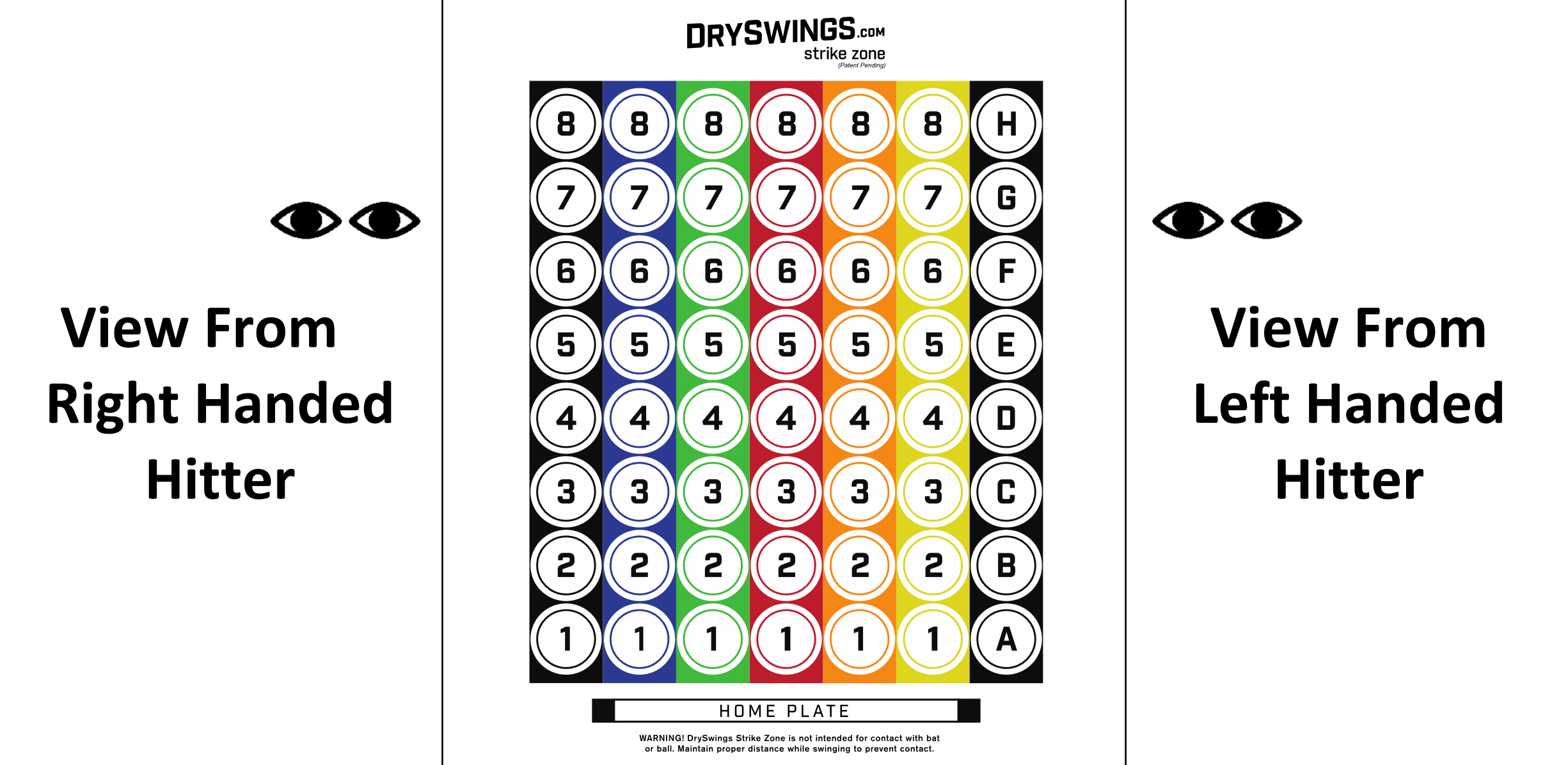
What the Color Locations mean for Pitch Location to a Righty or Lefty:
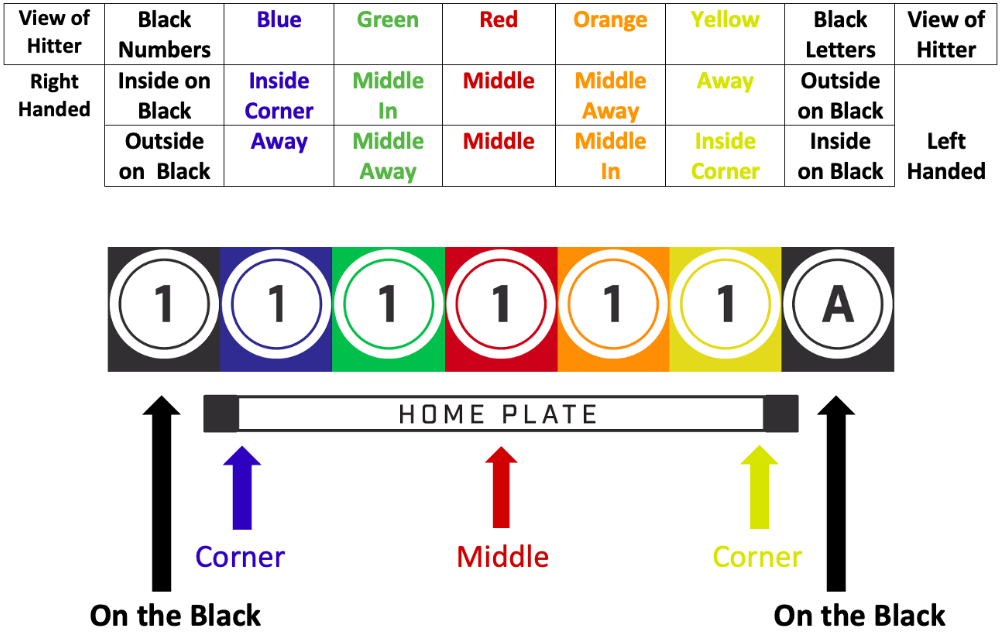
What the Number/Letter Locations mean to both Righty and Lefty:
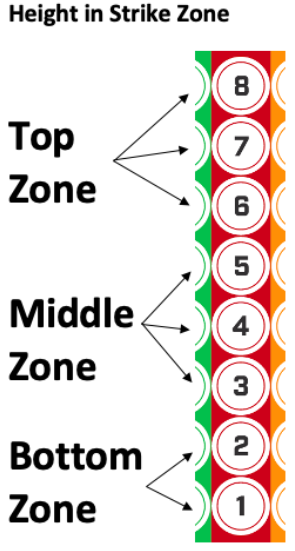
How to use Colors & #'s / Letters improve hitter's swing for Locations:
Besides being able to use a color and number/letter, there is the option to use horizontal locations relating to the 7 color columns.
Inside Black, Inside Corner, Middle In, Middle, Middle Away, Outside Corner, Black Away
Below is a Verbal Cue option to use for any hitters:
** Especially helpful for anyone with colorblindness **
FAQ/Videos
Coming soon!
Hitting Styles
While there are mechanical aspects that Must happen in every effective swing, We are firm believers that there are different types of swings for many different types of ball players. Observation of a professional baseball game or video analysis will show this. In fact, there will be success with all these styles, depending on the hitter, and attention to detail.
Some Examples of Different Styles of swing features include: small/long/no stride, High/No-leg kick, open/closed stance, squash the bug/to a toe/back foot off the ground/scissor back foot, wavy bat, knob to catcher, hand height & depth at load, front shoulder angle, hands/elbow path, letting ball travel, launch angle, contact with inner/outer half of the ball, top hand release, High follow through, extension, etc.
Whatever your hitting style and swing approach may be, practicing with the DrySwings Visual Aid of the Strike Zone, along with coaching, will help you replicate your swing, And hit any, and every pitch you may be challenged with.
Drills
Drills allow hitters to Fine Tune their SWING MECHANICS and mental approach for at-bats so they can easily replicate swings in game time situations. One of the main aspects to the DrySwings Strike Zone is with regards to bat path (plane of the ball/launch angle) and the ideal contact location (early in zone, even, deep in the zone).
Coaches, to critique bat path and mechanics, can stand in ANY of these locations:
- In front of hitter
- Opposite batter's box
- Behind (Homeplate, similar to umpire view)
Drill Option #1 Verbal Commands - Individual/multiple hitters:
At a field or indoor facility.
DrySwings Visual Aid mounted on Netting/Fencing, with a home plate on ground, hitter ready.
A coach can stand behind the Fence Aid is mounted on, to resemble a pitcher. Hitters focus on coach as a “pitcher”, coach completes pitching mechanics, calling out locations as completing a pitch, hitter reacts and competes chosen swing.
Just location called out:
Ex. 1
Coach says: "Blue 1, or Red 4, or Black 2"
OR
With Location, Counts, and Pitch Types:
Ex. 2
"2-0 Fastball Blue 1. Or 3-1 Changeup Red 4. Or 0-2 Curveball Black 2"
Drill Option #2 Written (Listed) on Paper/Whiteboard:
DrySwings Visual Aid mounted on Netting/Fencing, wiht a home plate on ground, hitter ready.
Pitch Location Only (same type of pitch):
Ex. 1
Blue 2, Red 6, Black 3, Green 1, Red 2
(All fastballs or all curveballs, etc.)
Pitch Location and Type of Pitch:
Ex. 2
Fastball Blue 2, Slider Red 6, Fastball Black 3, Curveball Green 1, Changeup Red 2
Pitch Locations and Count "Listed":
Ex. 3 - Writing on white board/paper with: Count and Location
0-0 Red 1, 1-0 Blue 3, 1-1 Brown 7, 2-1 Green 1, 2-2 Red 4
Most Detailed Option
Pitch Locations, Count & Type of pitch:
Ex. 4 - List "fastball" or "off-speed" after to focus on hitter getting stride foot down.
0-0 Fastball Red 1, 0-1 Off-speed Blue 3, 0-2 Fastball Black 7, 1-2 Fastball Green 1, 2-2 Fastball Red 4
Drill Option #3 Self Determined Pitch Location:
DrySwings Visual Aid mounted on Netting/Fencing, with a home plate on ground, hitter ready.
Hitter chooses on their own Pitch Location based on previous at bats and issues with certain pitches. Hitter would go at own pace for this approach.
Advanced Mirror Work:
Besides doing drills at the field, Mirror work is important for helping a hitter see all aspects of their swing and understand feedback/critique and apply concepts for effectiveness.
With proper spacing, a coach/teammate/parent could stand behind the hitter, lined up with the Visual Aid, in order to have the hitter view them as a “pitcher” via the Mirror. The “pitcher” could then go through the motion to replicate pitching the ball(set, separate, release), calling out a pitch location, which the hitter would then execute the desired DrySwing, Slow Motion Swing, Stop/Freeze at Contact or Aggressive Take. A coach/parent/teammate from this location in the mirror can not only be a pitcher, but also watch swing path mechanics and help fine tune and offer feedback based on the hitter’s hitting style.
Contact Us
(510) 413-3212
dryswings@gmail.com
Founded by Josh Silva. Assistant Varsity Baseball coach at College Preparatory School in Oakland, CA. Josh played baseball at San Leandro High School, Class of 1998 and was Team Captain Junior and Senior year at SS. While attending California State University Hayward (East Bay), Josh was a walk-on, playing for 2 years. Josh has continued playing baseball in the Tri-Valley Men's Senior Baseball League, and has participated in many traveling tournaments. Included in the traveling, was time with the East Bay Lumberjacks, and a small taste of Independent Ball in Hawaii in 2013.
The DrySwings Strike Zone was developed at home in San Leandro and is manufactured in San Leandro as well.
Each Unit/Tube Includes:
- 1 Visual Aid of Strike Zone for Baseball & Softball Players- 1 Shipping/Storage Tube
- 4 Carabiners (Attach 1 at all 4 grommet holes when in use)
- 2 Suction Cups (1 for each grommet hole at top of unit)
- Instructions

